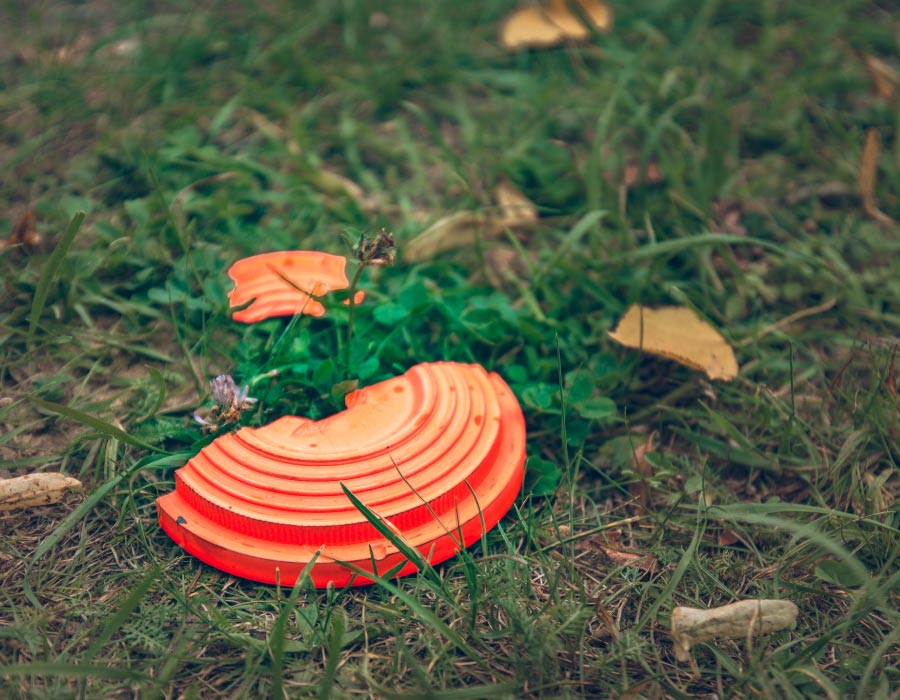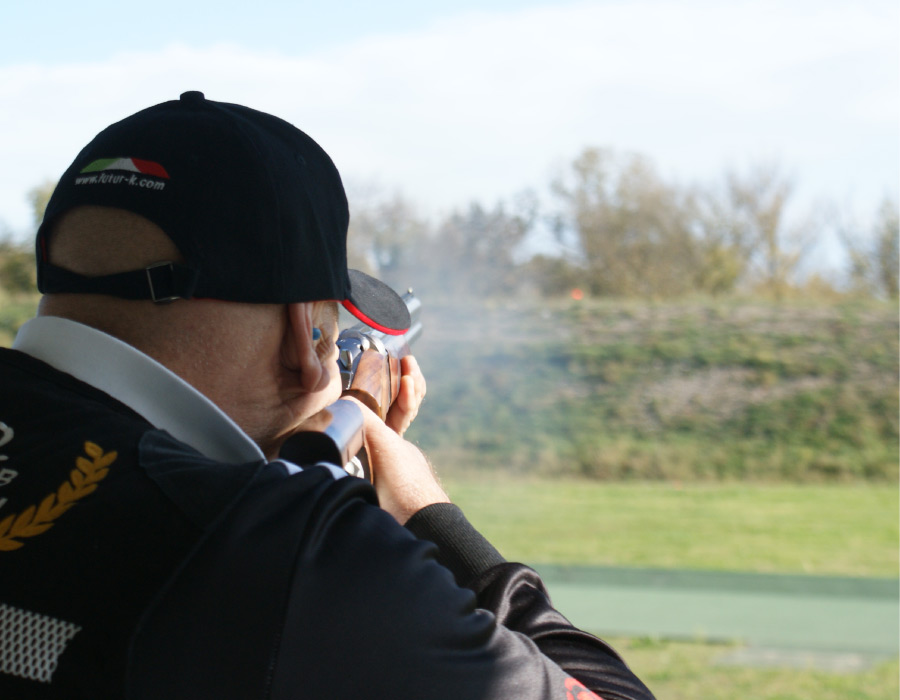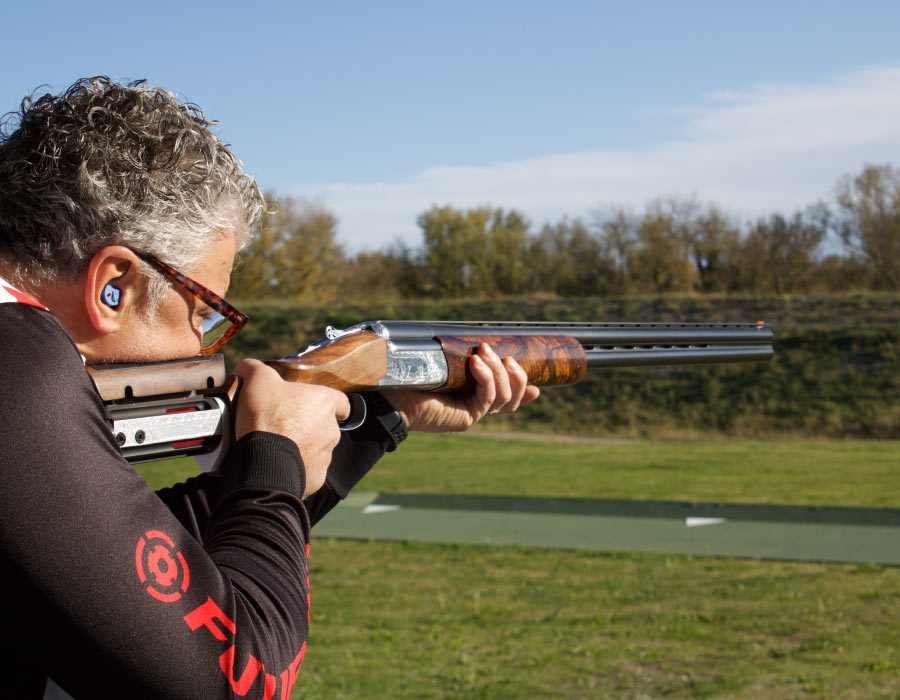In a previous blog post, we talked about everything needed to start clay pigeon shooting. We have already focused on how to choose a suitable shotgun for sports; now, it is time to figure out how to purchase the right shooting cartridge.
The market is very large, and cartridges differ based on the load and size of the shot and their use. By switching from a training to a competition cartridge, and being able to identify the right one, the results will certainly be better.
Therefore, the cartridge should not be overlooked because its variables can influence your shooting, changing the target engagement speed, and even the precision. As a result, the cartridges can have a positive or negative effect.
Before we look at how to find an excellent cartridge, it is important to briefly review how a cartridge is made.
- Shell case: it is the plastic tube that holds the shot and a wad. The closure at the base is composed of a brass head, while on the opposite side, the case is closed in the form of a star.
- Brass head: made of metal, it is located at the end of the shell case. It houses the primer with gunpowder.
- Gunpowder: it is held in a paper case, which serves to maintain constant pressure at the time of combustion.
- Wad: a material that stands between the explosive charge and shot. Its purpose is to avoid the dispersion of the gases that are released with combustion. In this way, the thrust generated by the combustion will be uniform.
- Shot: there are many different sizes.

How to choose the shooting cartridge: what you need to know
Many aspects must be taken into consideration when buying a stockpile of cartridges:
- Shooter’s experience
- Speed
- Shot
- Wad and load
Experience… makes a difference
Before buying (or changing) your stockpile, you should always start from your level of experience and your confidence on the platform. It is not appropriate to immediately start with a cartridge that is not suitable for you based on your knowledge, because not all of them are easily governed with a basic technique.
In the beginning, we recommend using basic cartridges, which can simplify the learning process. This is especially true while training, in which a 24-gram load can be used.
If one’s skills are advanced, or at least they are improving, one can experiment with different cartridges by “playing” on their components.
Speed
Speed seems like the easiest aspect to solve. The fastest cartridges should be the best performing, given their speed in reaching the target. All of this is true, but only partially.
Other very important settings are the shooter’s physicality, habits, and automatisms. Therefore, the right type of cartridge also varies from athlete to athlete.
How much can the speed of the shot vary?
Not long ago, almost all the cartridges that were used for clay pigeon shooting had a speed between 390 and 395 meters per second, a range that was considered a fair compromise.

All in all, it is a considerable standard to get the shot to the target, shattering it without difficulty. It is also very suitable for limiting the effects of recoil, an acceptable result even for the most sensitive shooters.
However, recently something has changed. Cartridges that exceed the speed that had previously become the standard have appeared on the market. They are called HV (the acronym for High Velocity) and are chosen by those who want an even faster shot. They are cartridges that, even with medium weights, can reach from 415 to 435 m/s.
Below, we have listed the advantages and disadvantages of fast cartridges:
Fast cartridges: advantages
The speed of engagement increases
The faster a shooting cartridge is, the sooner it reaches the target. It is a fairly obvious concept and perhaps one of the main reasons for choosing this type of cartridge.
With shorter times during the shooting phase, it will be less and less necessary to get ahead of the target’s trajectory. By giving up shooting in advance, you will increasingly follow the instinct to align the shotgun with the target and pull the trigger. Therefore, the chances of making a mistake will be less than average because the distance between the barrel and the target will be reduced by the considerable thrust of the cartridge.
Improve your performance
Strong wind affects the results of a shooting session. Heat and humidity can also change the performance and yield of the cartridge. Weather conditions are obviously a big obstacle to achieving good results. Fast cartridges are an advantage and their greater energy will not be completely exhausted before being able to shatter the target without difficulty.
The loss of power is a problem, but with fast cartridges, the shot pattern will travel, in the worst-case scenario, to the same levels as a standard cartridge. The other slower ones will risk, on the contrary, not being precise in breaking the target.
Therefore, shooting with a slow cartridge tends to anticipate the trajectory a lot, and with an unfavorable climate, hitting the target will become a very complex procedure.
It will be easier to break the target
A quick cartridge has more energy. Its impact on the target is consequently effective.
A hit that is poorly centered, however, may not be enough to break the clay into a thousand pieces, but it could break it into small parts that are not visible to the referee. To achieve this, it is good to use cartridges that give the shot a considerable impact.
Finally, a higher initial speed gives the outermost shot additional residual energy, which spreads over the whole pattern.

Fast cartridges: disadvantages
Beware of recoil
Those who start shooting with a faster cartridge will immediately notice some difficulties both in controlling the shotgun and in the recoil.
The experts are all in agreement in considering recoil as the first problem of extreme cartridges. We have already given you some suggestions on how to counter it, and if you haven’t done it yet, you can equip yourself with a high-performance stock, such as our Futur-K6AM, which has been designed to absorb up to 25% of the recoil.
However, the recoil must be kept under close observation, especially if you shoot in Skeet or Double Trap, where you have to move quickly from the first to the second barrel to hit the two targets.
Long sessions are likely to become exhausting
If a fast cartridge reaches the target first, the recoil will be significantly higher. This deficit, which multiplies every time the trigger is pressed in a series, will tire the shooter who, in the end, will immediately feel all the backlash on their shoulder and face.
The long-term use of these cartridges must be considered to measure the effort. An athlete can endure the annoyance depending on their physicality, but they do not know how long they will be able to maintain their concentration.
Pellets deform more
If the thrust generated by a cartridge is robust, the forces in the field will also surge. The same shot, when exiting the barrel, will be subjected to higher pressures.
The first consequence is that excessive impetus will cause the shot to undergo deformations during the initial deflagration, and these deformations will end with a less compact pattern and less spherical blow.
Dispersion is a big drawback for accuracy. To overcome this handicap, the shot must be carefully selected, focusing on quality productions and good hardness.

Shot: the best characteristics, discipline by discipline
In the previous chapter, the one related to speed, we underlined how concrete the risk of having to collide with the deformation of the shot is. The choice of their dimensions certainly makes the difference.
The disciplines of clay pigeon shooting have their own rules, and the specialties vary according to trajectories or engagement distances. Each one will need a correct organization of the shot in the shell case based on the fracturing power that will be needed.
The right size of pellet for the various disciplines
Here are the best configurations, referencing the main Olympic disciplines (we have also added the Hunting Path, a practice whose secrets we have already revealed, click here):
- Skeet, pellet from 9 – 9.5. The distances are short. In the central platform, we are confronted with nearby targets, while the farthest reach up to 26 meters. The smaller pellets (up to 2 mm) are preferred because their size helps you to center the nearby target. The fracturing power remains sufficient, and the patterns will be generous. Larger pellets still manage to break the target, but their pattern will be slightly lower in quality.
- Trap and Double Trap, pellet from 7 – 7.5 – 8. The distances are greater when compared to those of the Skeet. The pellet must be larger to maintain the right energy needed to reach the target, an objective that will be engaged in the second barrel even at 38 meters. We could suggest, for the first barrel, 8 pellet with a diameter of 2.3 mm or 7.5 (2.4), and 7.5 or 7 pellet should be chosen for the second barrel.
- Hunting Path, pellet from 8.5 – 9. The targets in this discipline are launched in different ways and at various angles and distances. Therefore, it is useful to know in advance the expected launch scheme, in order to choose the right cartridge.

The characteristics of shot
A quality shooting cartridge will have a number of factors that will set it apart from the competition. An important role is played by shot, which, in order to offer next-level performance, must meet two parameters:
- Sphericity. In the best cartridges, pellets are carefully selected. The form conserves its energy and reduces deviation. To increase the sphericity, you can resort to surface treatments (with a galvanic coating) or smoothing (with graphite).
- Hardness. Adding hardness develops the breaking capacity. That’s why antimony, a chemical element and semi-metal, is included in the lead alloy of the best pellets to optimize their properties. The result leads to dense patterns and small shot that retain their sphericity in the initial phase, despite the strong stresses.
Wad and load, the perfect setting to hit the target
The wad is a part of the shooting cartridge that has had a remarkable evolution. From the passage of paper cases to modern wads-containers made of plastic, its functions have increased, managing more and more to contain the combustion gases for the benefit of the blow.
There are now cartridges with special wads, which vary according to the load chosen and allow variations in the type of pattern desired. In Skeet, for example, the distances are short, and a balanced pattern will be needed.
However, the choice of the optimal wad must pass from testing to the plate, which we will discuss later.
Even the load has changed over time, allowing the shooter to be able to choose cartridges that go from 24 to 28 grams. You can switch from slow to fast charges, with the merits and defects of the case.
How to test the cartridge: here are the tests
Switching from one cartridge to another always requires a series of field tests. In these disciplines, being able to understand the effectiveness of the type of cartridge could be fundamental to obtaining a better score.
The market offers a very long list of solutions in the cartridge gamut, so it is good to have some solid foundations in order to find the most suitable product for your needs.
However, the most scientific way to really test the shooting cartridge is to perform plate tests. This procedure eliminates all subjective variables, allowing a complete ballistic view.
Our advice is to never replace your training with the plate test but to perform both steps. In general, a pack of 250 cartridges will suffice on average to get a general picture of their effectiveness. You can then decide whether to continue with those or choose other types of cartridges.

Plate tests: how to do it
These tests have two ultimate purposes: to evaluate the shot patterns, and also the fracturing power of the shot. In this way, you will be able to understand, first of all, the size and density of the patterns and also to follow the energy of the shot.
For a reliable result, the tests will have to be repeated several times, using at least five cartridges.
Distances
Each discipline has its own engagement distance. Therefore, the plate should be placed following some criteria listed below:
- Trap. The plate goes between 27 and 31 meters for the first barrel, while for the second, it should reach 36 meters, which is a suitable distance for recovery shots.
- Skeet. The recommended distance is between 20 and 22 meters, ranges in which the target is usually engaged.
- Hunting Path. Launches vary widely, but the overwhelming majority of hits occur between 25 and 30 meters.
Once the plate tests are over, you can move on to the shooting range, perhaps starting with known patterns to quickly become familiar and gain confidence with the new cartridges.

